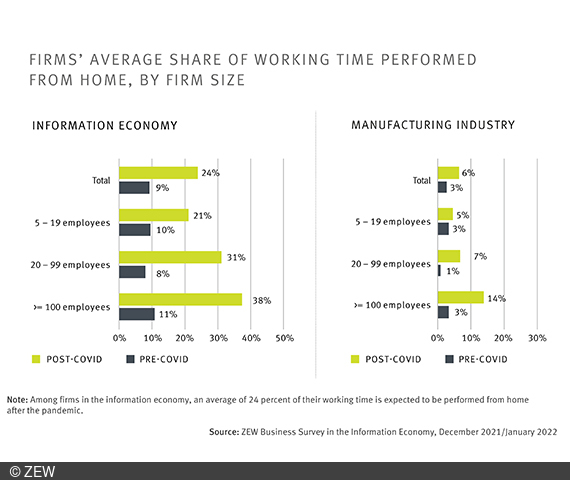Working Time Performed from Home Increases Strongly in the Long Term – Especially in Large Firms
ResearchAs a result of the COVID-19 pandemic, firms in Germany expect a strong increase in the amount of working time performed from home in the long term. As a recent business survey by ZEW Mannheim shows, firms in the information economy expect an average of 24 per cent of their employees’ working time to be done from home after the pandemic. Before the pandemic, this share was only 9 per cent of working time. Meanwhile, in the manufacturing industry, the average proportion of time worked from home doubles from 3 per cent before the pandemic to 6 per cent afterwards. “Small, medium and large firms all expect a significant increase in the share of working time from home. However, the expected shift to working from home is most pronounced in large firms,” says Dr. Daniel Erdsiek, researcher in ZEW’s “Digital Economy” Department.
Around 1,000 firms from the manufacturing industry and the information economy, which includes the ICT sector, media service providers and knowledge-intensive service providers, took part in the representative survey in December 2021 and January 2022. The firms were asked how often they had used hybrid working models before the pandemic and to what extent they plan to offer them after the pandemic. The hybrid working models differed in the number of home-working days, ranging from 1 to 4 days per week. In addition, the model with 5 home-working days per week has been surveyed and is sometimes subsumed under the term hybrid model in the following text for better readability. For each of the five models, the firms indicated the share of employees likely to use that model. On the basis of this detailed information, it is possible to estimate the share of the total working time in a firm that is likely to be performed from home. The underlying assumptions are that a work week consists of 5 days for all employees in a given firm and that the employees’ working time is distributed evenly over those 5 days. Based on these assumptions, each day of a work week corresponds to 20 per cent of an employee’s working time.
Average share of time worked from home increases significantly
Before the COVID-19 pandemic, the average share of working time performed from home was 9 per cent in firms in the information economy and 3 per cent in firms in the manufacturing industry. For the post-pandemic period, firms expect 24 per cent of working time in the information economy and 6 per cent of working time in manufacturing to be done from home. Comparing the average figures over time thus shows that the share of home-based working time will multiply in the long term according to the firms in both sectors. This is especially true for larger firms, in which the shift towards home-based work is even more pronounced than in smaller firms. For example, large firms with at least 100 employees in the information economy expect that after the pandemic an average of 38 per cent of the working time of their employees will be performed from home. For comparison: before the pandemic, this share was still 10 per cent. Also in the manufacturing industry large firms see the most significant shift towards home-based work and expect 14 per cent of working time to be performed from home after COVID (compared to 3 per cent before the pandemic).
Considerably more firms plan large-scale shift towards home-based work
“Before the pandemic, only in one out of ten firms in the information economy did work from home account for more than 30 per cent of total working time. For the period after the pandemic, however, one third of the firms now expect such a high share of home-based working time. The corresponding share of firms has thus tripled in the course of the pandemic,” says Erdsiek. Overall, 15 per cent of the firms even expect that in the long run more than half of the total working time will be done from home. Here, too, the expectations correspond to three times the pre-crisis level. In manufacturing, on the other hand, only a few firms expect more than 30 per cent or even 50 per cent of working time to be performed from home after the pandemic. However, almost one in five firms expect more than 10 per cent of working time to be performed from home after the pandemic (compared to only 4 per cent of firms before COVID).
“The likelihood of firms expecting intensive use of working from home practices is strongly related to their size,” says Erdsiek. In the information economy, for example, 58 per cent of large firms expect more than 30 per cent of total working time to be done from home after the pandemic. Just under 25 per cent of large firms expect more than 50 per cent of their employees’ working time to be performed from home. In small firms with 5 to 19 employees, on the other hand, only about half as many firms expect a comparably intensive use of home-based work (29 per cent and 13 per cent of firms, respectively). Nevertheless, firms of all sizes are recording a clear and long-term boost in home-based work compared to pre-pandemic levels.
In the manufacturing industry, it is mainly smaller shares of total working time that are shifted to home-based work. While almost half of the large firms expect more than 10 per cent of working time to be done from home after the pandemic, this is true for only about one in ten of the small firms. Meanwhile, 12 per cent of large firms and 6 per cent of small firms expect more than 30 per cent of working time to be done from home (before COVID, the figure was about 3 per cent in each case). However, the share of firms that expect more than half of the working time to be performed from home remains relatively unchanged in manufacturing for all firm sizes, at around 3 per cent.

